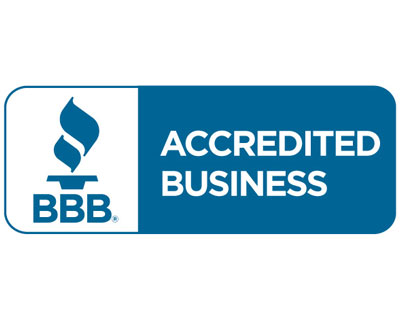The kitchen is more than just a cooking space; it’s the heart of the home. Naturally, the kitchen floor endures more wear and tear than any other area in the house. It must withstand constant foot traffic, frequent spills, heat, and dropped utensils. Therefore, choosing sturdy, durable, and low-maintenance flooring is crucial. The key to finding the best kitchen flooring for your home lies in balancing design, function, and comfort—especially if you’re planning to pair it with kitchen cabinetry that reflect your personal style.
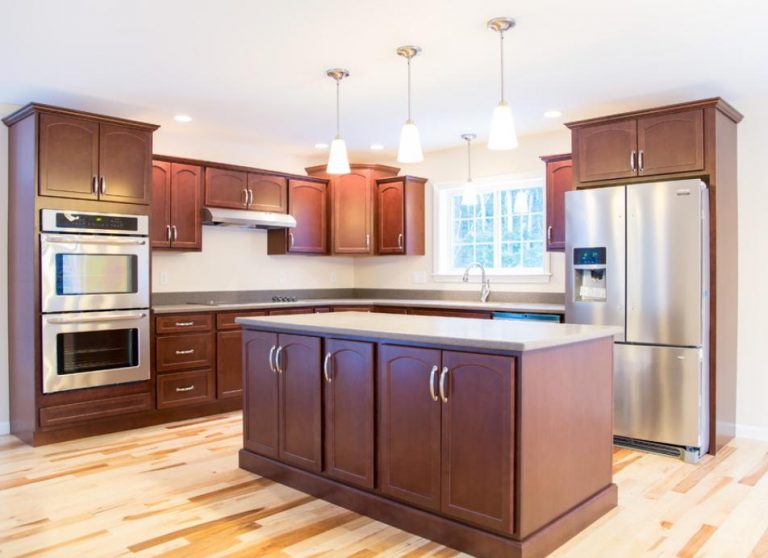
While shopping for kitchen floor options, keep the following key points in mind:
- Durability: Look for flooring that can withstand high traffic and dropped utensils.
- Installation: Check the ease of installation and whether professional help is required.
- Style and Design: Flooring should look in sync with the design of the rest of the kitchen.
- Comfort: Consider how comfortable the flooring feels underfoot, especially if you spend a lot of time standing.
- Water Resistance: The kitchen is a semi-wet area and frequent spilling of water should not damage the flooring.
- Easy to Clean: The flooring should not have any grooves where dirt gets stuck. Look for seamless flooring options for easier cleaning.
- Budget: Determine your budget and explore options that offer the best value within your price range.
With a wide assortment of materials available in the market, the following flooring ideas for kitchens are fantastic picks.
Tiles
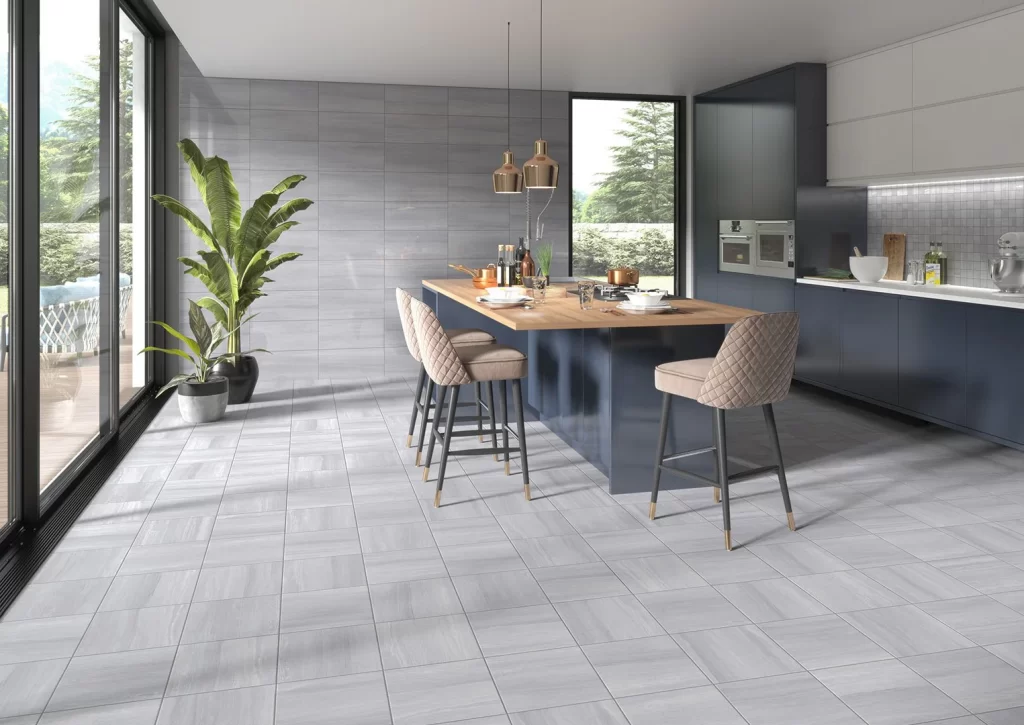
Tiles offer some of the best flooring for kitchens and bathrooms, or in other words, areas susceptible to moisture. Tiles can last a lifetime if installed, grouted, and sealed properly. The popular options for kitchen tile flooring are ceramic, porcelain, and natural stone.
Ceramic tiles are some of the most durable flooring materials, made from clay and fired under extreme heat. They are impact and water-resistant and are easy to maintain. Ceramic tiles can endure any amount of spills, splatters, and messes that can be wiped away with a mop or sponge easily.
Porcelain tiles can be a bit more brittle if not installed properly, but they’re still extremely durable and easy to maintain. Natural stone is the most expensive option of the three, and requires a little more maintenance and regular resealing. It is popular because of its natural finish. Natural stone also tends to be more non-slip thanks to its semi-porous nature.
Pros
- Available in numerous colours and patterns
- Requires minimal upkeep
- Heat and water-resistant
Cons
- Cold and hard underfoot can be uncomfortable to stand on for long periods
- Not recommended for second-story kitchens
- Needs to be installed professionally
Vinyl
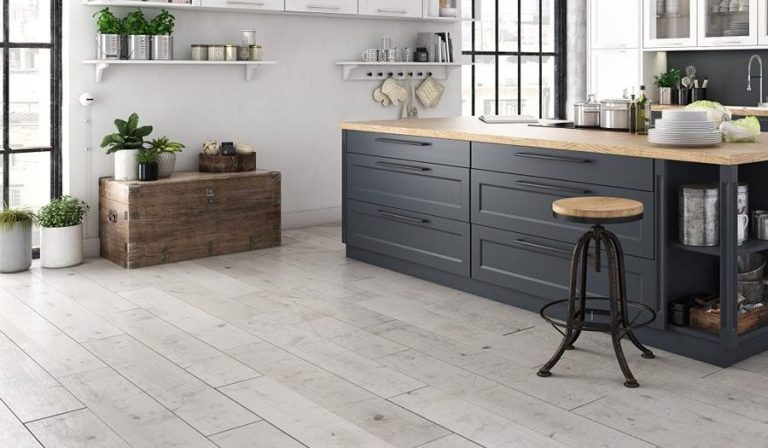
Compared to tile, vinyl is more DIY-friendly, perfect for those with limited budgets for installation. Vinyl flooring options are available in two compositions: WPC (Wood Plastic Composite) or SPC (Stone Plastic Composite). These synthetic flooring materials come in large sheets of stick-down tiles.
Luxury vinyl tile (LVT) is another type of vinyl that’s been gaining popularity for its ability to replicate the look of high-end materials while being five times thicker than traditional vinyl. Since it’s more rigid than regular vinyl, LVT comes in vinyl planks that can be snapped together instead of sheets that can be rolled out and glued together. Plank vinyl flooring can also imitate the look of premium materials much better than its sheet counterparts.
For those committed to the DIY route, vinyl is the best type of flooring for kitchen renovations or remodelling on a budget. It’s fully waterproof, versatile, and comfortable underfoot.
Pros
- Can mimic the appearance of more expensive flooring options like hardwood, stone, and ceramic tiles
- Affordable, both in terms of initial cost and long-term maintenance
- Easy to install even for those with little to no experience
Cons
- Not as durable as other kitchen floor options
- Designs can look cheap on low-quality, traditional sheet vinyl
- Susceptible to dents and scratches especially when moving heavy appliances
Concrete
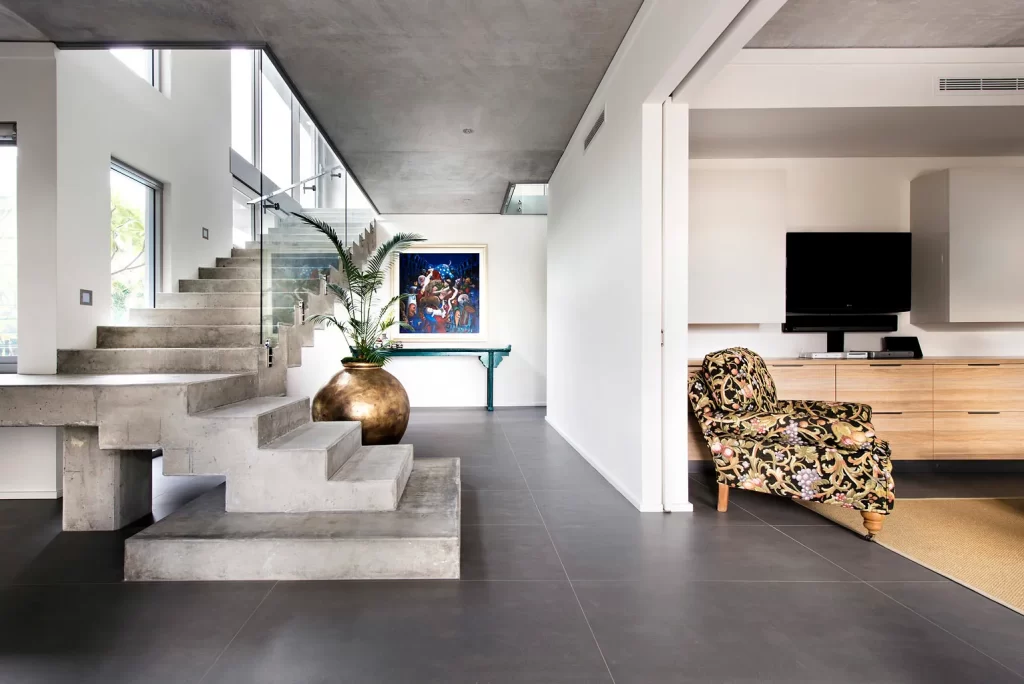
Concrete may sound industrial, but when polished and stained, it becomes a stylish, long-lasting option that suits many contemporary kitchen styles. This type of flooring works well if your cabinet maker is designing a minimalist or industrial kitchen layout. It’s especially fitting for kitchens featuring sleek, modern custom cabinets.
Concrete is one of the best flooring types for a busy kitchen. It is an inexpensive and long-lasting durable kitchen flooring option. Polished concrete floors are also pretty flexible and can be waxed to give different finishes depending on the style of the kitchen.
Although extremely durable, concrete requires a little bit more upkeep than other flooring types. Because of its porous nature, it needs to be resealed regularly to protect it from water damage. It also isn’t ideal for kitchens that are on top of a basement or crawl space. If you want concrete floors, your kitchen needs to be at ground level or sitting on top of a concrete slab to fully support the weight of the material.
Pros
- Extremely durable for its price
- Heat and impact-resistant
- Can be stained to look like wood, stone, or tile
Cons
- Can look a bit too industrial
- Cold and hard underfoot
- Requires more maintenance
- Not appropriate for all kitchens
Hardwood
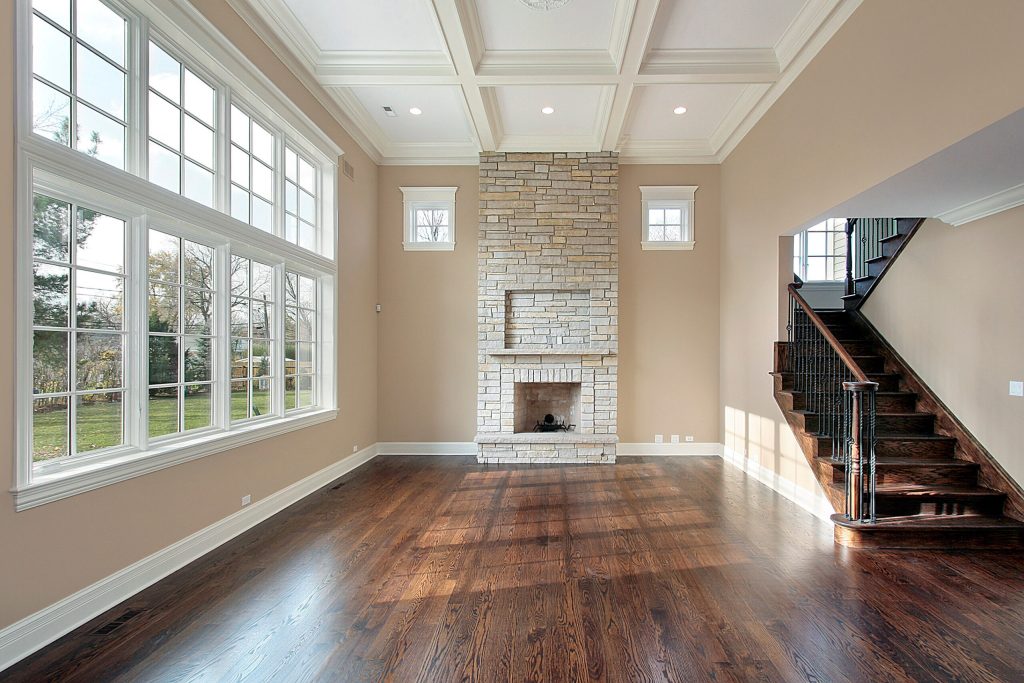
Solid hardwood flooring may just be the most popular kitchen flooring due to its aesthetic appeal. It is on the higher end of the price scale and is the material most commonly imitated by other flooring types such as laminate, vinyl, and engineered wood. Hardwood is highly coveted due to its rich, natural grain patterns and warm, inviting look.
While solid hardwood is not inherently resistant to moisture, advancements in modern sealers and polyurethane finishes have significantly improved its durability. These finishes create a protective layer that helps safeguard the wood against water damage, scratches, and stains. With proper care and maintenance, solid hardwood floors can last for decades, making them a long-term investment for homeowners.
Pros
- Can be sanded and refinished to make it look brand new
- Increases the resale value of your property
- Available in various colours and patterns
Cons
- Pricier than other flooring types
- Can warp and swell due to moisture
- Prone to scratches and dents
Cork
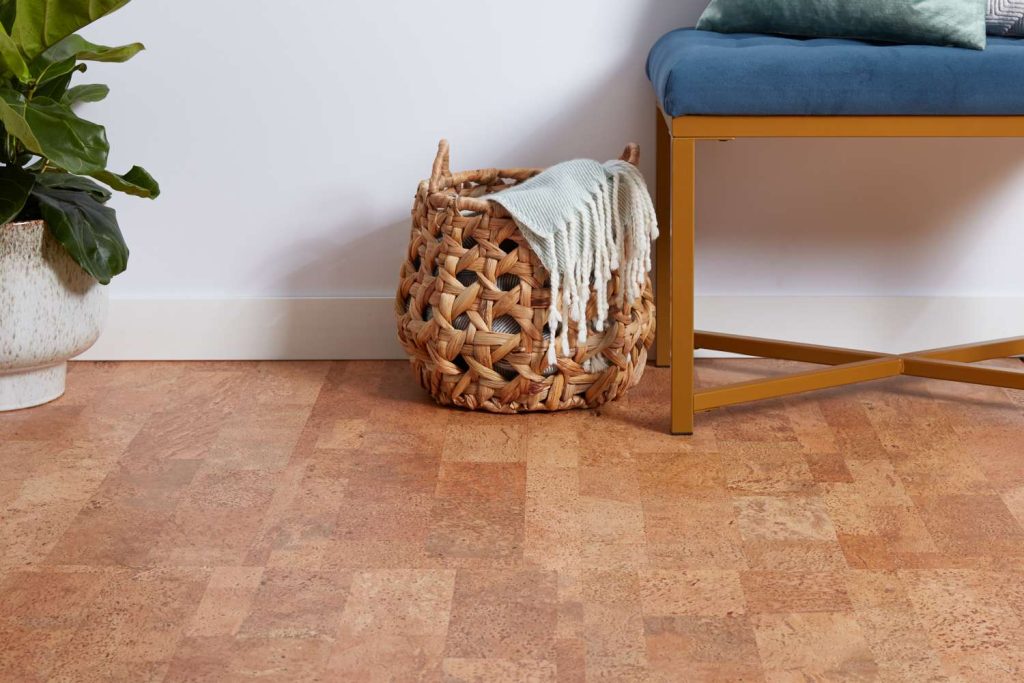
Cork is one of the best kitchen floor materials for those who prioritize sustainability. It provides a soft, comfortable underfoot, and is renewable, inexpensive, and stain-resistant. The harvesting process involves removing the bark from cork oak trees, which naturally regenerate their bark every few years. This method does not harm the trees, allowing them to continue growing.
While cork flooring is relatively soft compared to other materials, it is pretty resilient and can recover from minor impacts and indentations. Cork also has excellent thermal and acoustic insulation properties.
Pros
- Affordable
- Can be produced and manufactured sustainably
- Provides good underfoot cushioning, making it more comfortable than other flooring types
Cons
- Can fade under direct sunlight
- Susceptible to dents and scratches
- Prone to staining and water damage if not properly sealed
Bamboo
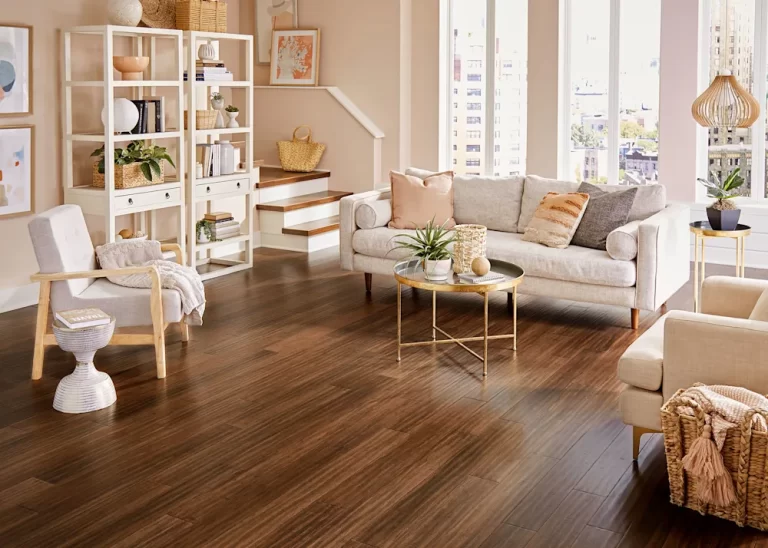
Bamboo flooring is another eco-conscious option that’s been gaining popularity in recent years. It’s more durable than hardwood and can be manufactured for better moisture resistance. Bamboo flooring comes in several types, each with unique benefits.
Horizontal bamboo flooring highlights the natural nodes of the bamboo for a textured look, while vertical bamboo offers a sleek, uniform grain. Strand-woven bamboo is highly durable, surpassing many hardwoods in hardness, and is ideal for high-traffic areas. Engineered bamboo, with a bamboo veneer over a stable core, offers added stability and can be installed over various subfloors.
Pros
- Can be more durable than hardwood
- Provides better moisture resistance for busy kitchens
- Environmentally-friendly
Cons
- Limited range of shade options
- Quality can vary between manufacturers
- Limited number of refinishes for engineered bamboo
Laminate
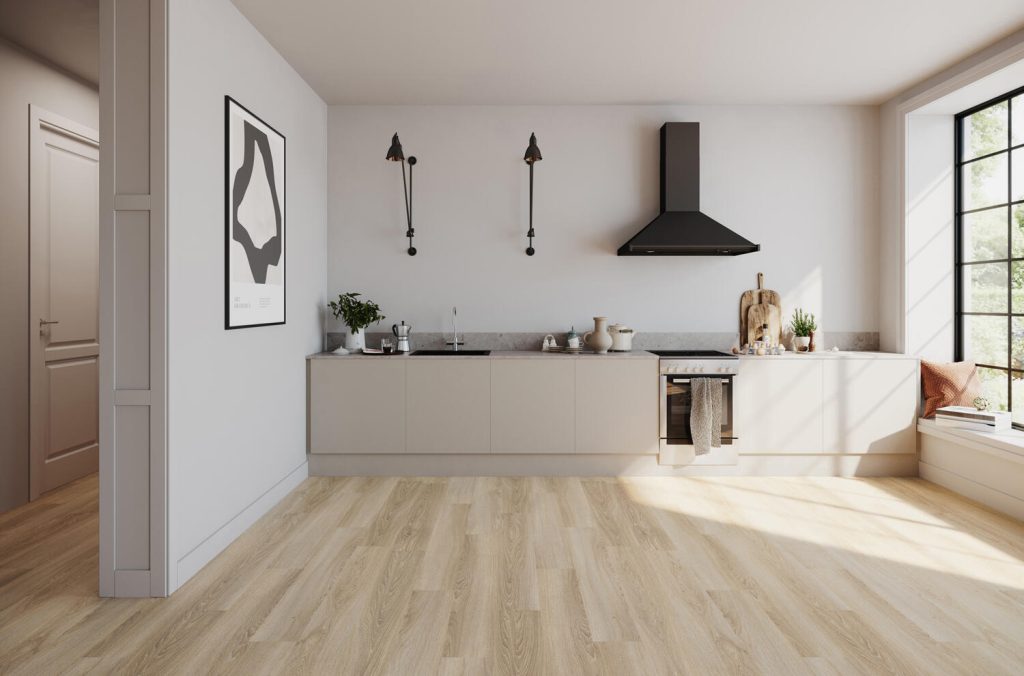
Laminate is made of a high-density fiberboard (HDF) core topped with a photographic image layer that mimics wood, stone, or other materials, and a clear protective wear layer. It is typically installed as a floating floor with click-and-lock planks that do not require adhesive.
It is resistant to scratches and dents, but not as moisture-resistant as vinyl. Prolonged exposure to water can cause the core to swell. Laminate also has a slightly softer underfoot compared to vinyl thanks to its thicker core.
Pros
- Easy to install and great for DIYers
- Wide range of design choices
- Affordable and requires minimal maintenance
Cons
- Excess water can cause the material to warp or stain
- Cannot be sanded or refinished once damaged
- Some laminate finishes can be slippery when wet
Choosing the Best Kitchen Flooring for You
When choosing the best kitchen flooring, consider factors like durability, maintenance, and aesthetic appeal. Porcelain tile and luxury vinyl tile (LVT) are top choices due to their excellent water resistance and durability, making them ideal for busy kitchens. Hardwood offers timeless beauty but requires careful maintenance to protect against moisture.
For eco-friendly options, bamboo and cork provide sustainable and stylish solutions, though they may need sealing for added protection. Coordinate your flooring with custom cabinetry from Seattle Cabinets to achieve a cohesive and visually appealing kitchen design for your home.




